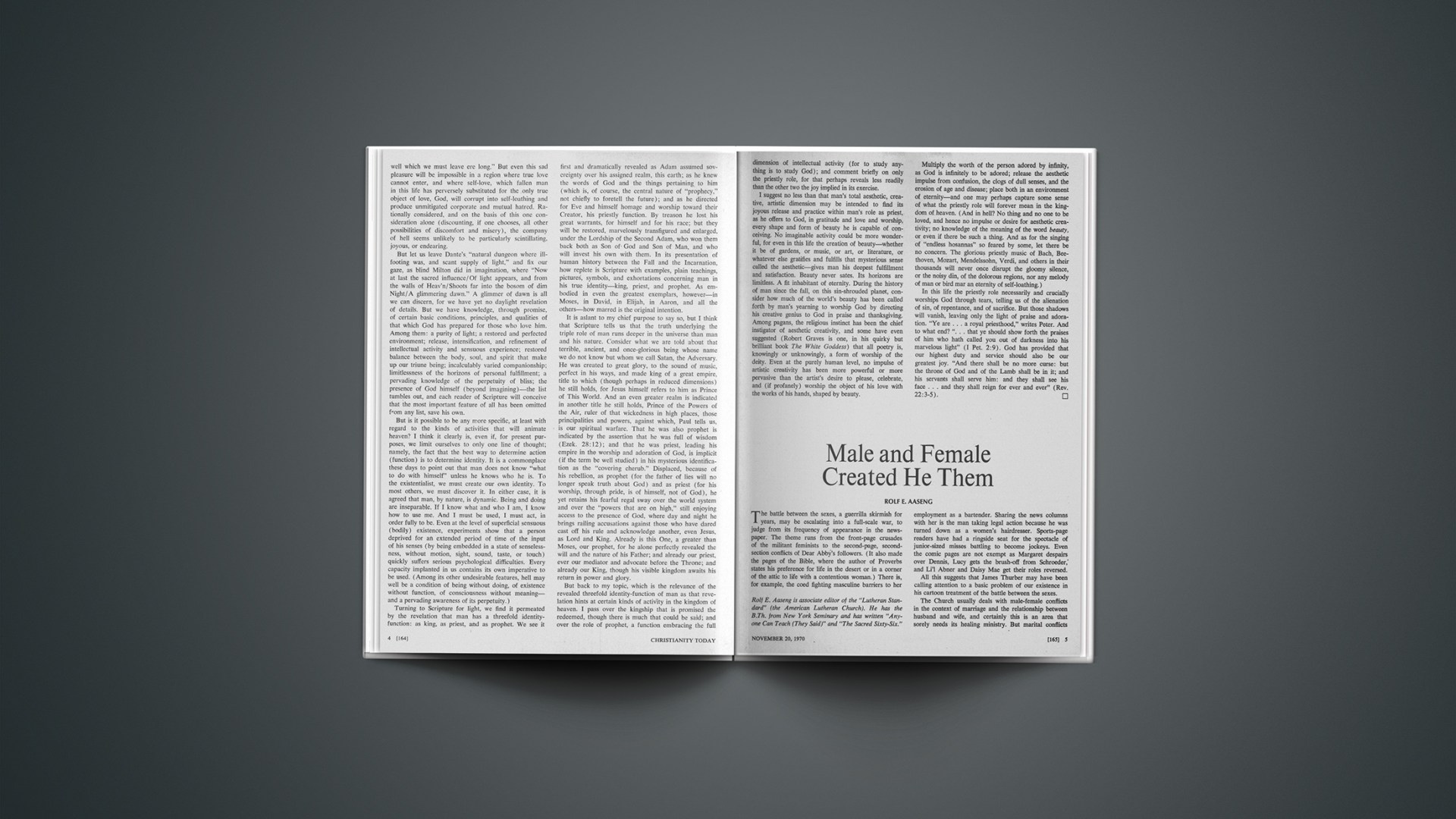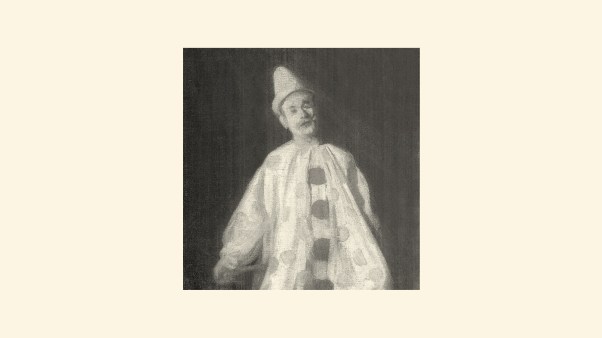The battle between the sexes, a guerrilla skirmish for years, may be escalating into a full-scale war, to judge from its frequency of appearance in the newspaper. The theme runs from the front-page crusades of the militant feminists to the second-page, second-section conflicts of Dear Abby’s followers. (It also made the pages of the Bible, where the author of Proverbs states his preference for life in the desert or in a corner of the attic to life with a contentious woman.) There is, for example, the coed fighting masculine barriers to her employment as a bartender. Sharing the news columns with her is the man taking legal action because he was turned down as a women’s hairdresser. Sports-page readers have had a ringside seat for the spectacle of junior-sized misses battling to become jockeys. Even the comic pages are not exempt as Margaret despairs over Dennis, Lucy gets the brush-off from Schroeder, and Li’l Abner and Daisy Mae get their roles reversed.
All this suggests that James Thurber may have been calling attention to a basic problem of our existence in his cartoon treatment of the battle between the sexes.
The Church usually deals with male-female conflicts in the context of marriage and the relationship between husband and wife, and certainly this is an area that sorely needs its healing ministry. But marital conflicts may be a symptom of a more basic human problem that happens to show up most clearly under the magnifying glass of a marriage relationship. The Church should speak to its entire membership, not just the married, on the matter of male and female relationships.
To get some clues to how the sexes should relate to each other, let’s go back to the beginning. The creation account states, “God created man in his own image, in the image of God he created him; male and female he created them” (Gen. 1:27). This seems to say that the image of God, in which mankind was created, is a double image: it includes both male and female. Biblical references to God as a man are apparently an accommodation to the limitations of human language. What God is encompasses both sexes, and since we have never seen such a being we have no adequate way of describing him.
The Genesis account clearly shows that none of us, male or female, is complete in himself—and this was true even before sin spoiled things. We need the opposite sex to help us form an image, faint though it may be, of God.
This notion is supported by God’s comment in creating Eve: “It is not good that man should be alone. I will make him a helper fit for him” (Gen. 2:18). We have accepted the archaic terms “helpmate” and even “helpmeet” from earlier translations without giving much thought to their original meaning, and so may miss some of the significance of this passage. It emphasizes the incompleteness of the man God had created, even though his creation was “good.”
Sexual union between male and female is one means of attaining a part of the completeness that was intended. But it is not the only way. God’s will does not make second-class citizens out of any group. Although marriage is intended to bring particular blessings, there is certainly no suggestion that the unmarried are excluded from God’s blessings.
Male and female need each other, even apart from sexual union. Men or women who have spent some time in a single-sex environment—the armed forces, for example—are well aware that this is not ideal.
The fulfillment of God’s intention in creation depends on significant contributions from both male and female. What happened to this intention? Sin happened, as it so often does. Even among the chosen people, women were not considered equal contributors to the wholeness of God’s image. Their rights were not as important as those of men; for example, they normally did not hold property. In general, instead of being free to make their contribution to the purposes of God, women were regarded as passive recipients of the leftovers of God’s largess.
To say that Jesus came to take away sin is to say a good deal more than most of us have in mind when we make that statement. Jesus not only takes away the guilt and punishment of our individual and collective sins, great as that truth is; he comes also to set right all those things that sin has upset, to bring about the completeness God had in mind in creation. And among the benefits he brings is a restoration of the equality of the sexes. He gives to women their intended place in God’s order—full partners in reflecting the image of God.
Paul summarizes this when he tells the Galatians, “There is neither Jew nor Greek, neither male nor female, for you are all one in Christ Jesus” (Gal. 3:28). This unity, brought about by the full participation of both men and women, is God’s intention.
What about passages that speak of the man as the head and the woman as subject to him? Before we build an entire style of life on these verses we should consider what the Bible as a whole has to say on this subject, not overlooking passages (as in Proverbs) that exalt womanhood, or the examples of women such as Deborah who played prominent roles among God’s people. The Apostle Paul—whose statements about the place of women in the church are well known—seemed entirely at ease when Lydia took over leadership in the first congregation in Europe.
When Paul told wives to be subject to their husbands, he also told the husbands to love their wives. And if a man loves a woman, he is in a very real sense willing to be subject to her. Paul makes this point clear by reminding us that Christ loved the Church so much that he gave himself up for her. Jesus calls us to the same kind of self-sacrificing service as the mark of our love.
When biblical writers assign to women a subservient position, they are not talking about equality or status or prestige, for after all, “the last shall be first.” It might be helpful to think of such designations as a description of function or responsibilities.
To say that the sexes are equal is not to say that they are the same. Vive la difference! Many, both male and female, seem to have a hangup at this point and become overly aggressive or defensive on the matter of women’s rights. But we don’t have to be alike to be equal.
We may reasonably infer that each sex supplies something to help complete the oneness of which Paul spoke. The man or the woman does not necessarily contribute the same ingredient to each combination. Nor is the proportion supplied by the one sex the same in every circumstance. But both, whatever the nature and amount of their contribution, are necessary to wholeness.
Part of what we are is what others make us. Marriage, because of its constant intimacy, provides the greatest opportunity for this completing relationship. But all of us are influenced and brought somewhat nearer to reflecting God’s image—or farther from it—by those around us. And our personality suffers if some of this influence is not exercised by those of the opposite sex.
Paul stresses this interdependence when he writes to the Corinthians, “In the Lord, woman is not independent of man, nor man of woman; for as woman was made from man, so man is now born of woman” (1 Cor. 11:11). God’s creatures are interdependent. Men and women must each contribute to the reflection of God’s image if the wholeness he intended in creation is to be achieved.
Rolf E. Aaseng is associate editor of the “Lutheran Standard” (the American Lutheran Church). He has the B.Th. from New York Seminary and has written “Anyone Can Teach (They Said)” and “The Sacred Sixty-Six.”










